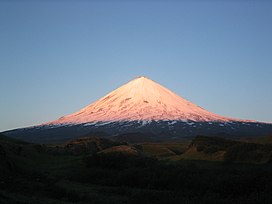| Klyuchevskaya Sopka | |
|---|---|
 Klyuchevskaya Sopka in January 2007 | |
| Highest point | |
| Elevation | 4,754 m (15,597 ft) |
| Prominence | 4,649 m (15,253 ft) Ranked 13th |
| Listing | Ultra |
| Coordinates | 56°03′22″N 160°38′39″E / 56.056044°N 160.644089°E |
| Geography | |
Location in Kamchatka Krai, Russia | |
 | |
| Location | Kamchatka, Russia |
| Parent range | Eastern Range |
| Geology | |
| Mountain type | Stratovolcano (active) |
| Last eruption | 2023 |
| Climbing | |
| First ascent | 1788 by Daniel Gauss and 2 others |
| Easiest route | basic rock/snow climb |
Klyuchevskaya Sopka (Russian: Ключевская сопка; also known as Klyuchevskoi, Russian: Ключевской) is a stratovolcano, the highest mountain of Siberia and the highest active volcano of Eurasia. Its steep, symmetrical cone towers about 100 kilometres (60 mi) from the Bering Sea. The volcano is part of the natural Volcanoes of Kamchatka UNESCO World Heritage Site. Klyuchevskaya Sopka is ranked 15th in the world by topographic isolation.
Klyuchevskaya appeared 7,000 years ago.[1] Its first recorded eruption occurred in 1697,[1] and it has been almost continuously active ever since, as have many of its neighboring volcanoes. It was first climbed in 1788 by Daniel Gauss and two other members of the Billings Expedition.[2] No other ascents were recorded until 1931, when several climbers were killed by flying lava on the descent. As similar dangers still exist today, few ascents are made.
- ^ a b "Klyuchevskoy: Eruptive History". Global Volcanism Program. Smithsonian Institution. Retrieved 2021-06-25.
- ^ Dobkin, Josef (1989), "The Living Giants of Kamchatka", The American Alpine Journal, The American Alpine Club: 104, ISBN 0-930410-39-4
